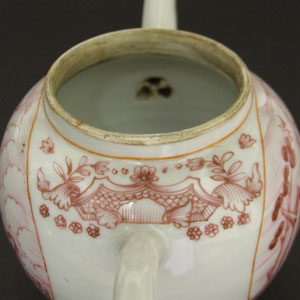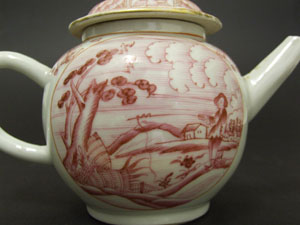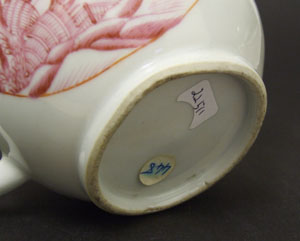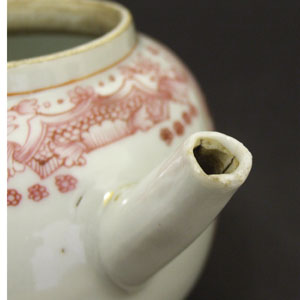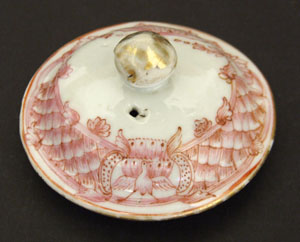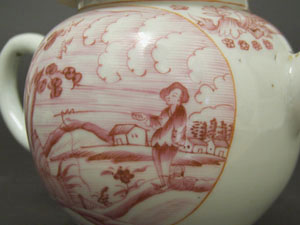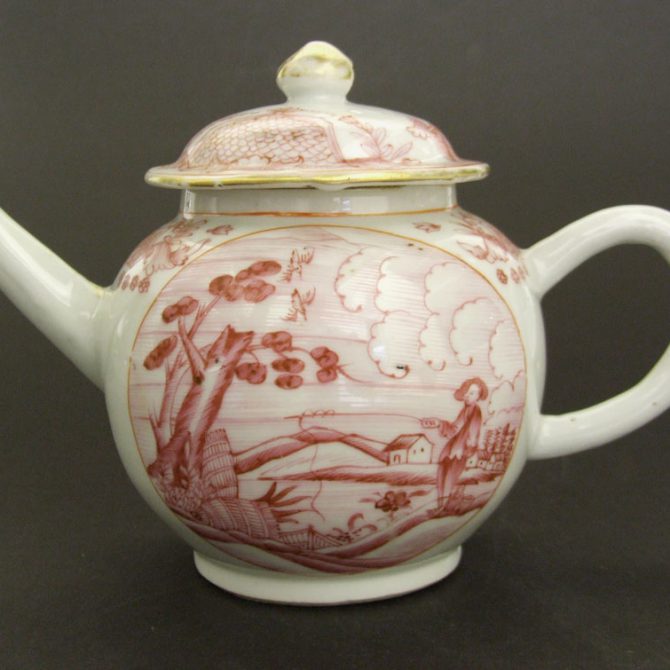
QIANLONG 1736 – 1795 Chinese Export Porcelain
An 18th Century Chinese Export Porcelain Teapot and Cover, Qianlong Period c.1750. Painted in Camaïeu Rose with `Le Pêcheur` After A.Bloemaert. The Scene Shows a Young Man Standing on the Riverbank with his Line Cast into a Lake, He has no Shoes on and One Arm to His Side, on the Bank Next to Him is a Small Jar, a Basket. To the Left is an Old Broken Half Dead Tree with Two Birds Flying Above, Below the Tree are Two Basket Fish Traps. The Hilly Shore Line on the Other Side of the Lake has Small Buildings Among Trees and Bushes. This is a Some What Simplified Version of this Design. The Border is of Laub Und Badelwerk.
SOLD
- Condition
- N/A
- Size
- N/A
- Provenance
- N/A
- Stock number
- 22511
Information
`Le Pêcheur` After A.Bloemaert :
The subject of a young man fishing on the river bank is taken from a design in a sketch-book by the Dutch artist Abraham Bloemaert (1566 - 1651) and published by Claes Janszoon Visscher (1586 - 1652). The original print tells us it was taken from a design by Bloemaert but it doesn`t tell us who engraved it, however it is likely it was an engraver from the workshop of Visscher, if not by his hand. Visscher was an engraver and publisher from Amsterdam who`s trademark was, coincidentally, a fisherman, after the family name, thus the Latin nickname for the father and son of Piscator. In some of his maps and prints a small fisherman would be strategically placed somewhere near water. If the subject was a landscape without a stream or pond, then often a figure walking with a fishing rod can be seen. However it is only a coincidence that the subject of this print is a fisherman. Fishing, or angling, was during the 18th century, because of the symbolism of the fish, regarded as a symbol of true love. This design by Bloemaert is well known on mid-18th century Chinese Export Porcelain, it was produced from about 1740 to the 1750`s. It occurs with many variations using various palettes, including a muted Famille Rose, En Grisaille and Puce.
Laub Und Bandelwerk :
Laub und Bandelwerk is a German term meaning foliage and scrollwork, it is a late baroque style of ornament developed in Europe in the early 18th century. This group of designs with broken trellis, `C` shaped scrolls, formalized leaves, strapwork and sashes was used to decorate rooms sometime combined with grotesques. However, Laub und Bandelwerk was more often used as a decorative border in the applied arts. It was employed on 18th century European porcelain, especially that of Du Paquier of Vienna, Doccia in Italy and Meissen in Germany, rarely was it used as the main design but it`s strong angular forms created dramatic border designs. It is therefore unsurprising that it was used on Chinese export porcelain, either in en grisaille or Camaïeu Rose ( puce ). Laub und Bandelwerk borders were used on Chinese export porcelain in the mid 18th century in designs such as `Le Pêcheur` after A.Bloemaert or `Juno and the Peacock`. For an engraving by Johann Jacob Baumgartner (active around 1720-1727) used as a source for a Laub und Bandelwerk designs see : Baroque Luxury Porcelain, The Manufactories of Du Paquier in Vienna and of Carlo Ginori in Florence, Exhibition 10 November 2005 – 29 January 2006 ( various authors, Liechtenstein Museum, Prestel, 2005. ISBN 3-7913-3499-9) page 302, plate 132.
